Patagonia Womens Merino Thermal Weight Zip Neck Blue Stripe
A city-to-trail shirt: Ridge Merino Aspect Midweight Wool Base Layer Long Sleeve Shirt
Our pick
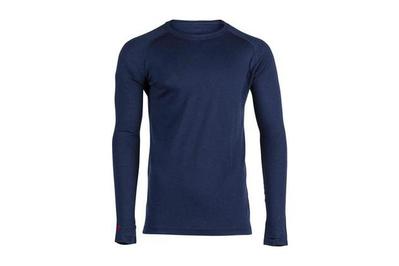

Get this if: You want a shirt that occupies the middle ground. You'd like it to pass for a casual shirt, but you also want to wear it as a base layer when you're biking, hiking, or hitting the slopes.
Why it's great: The Ridge Merino Aspect Midweight Wool Base Layer Long Sleeve Shirt is a technical shirt that doesn't look too technical. (By technical, we mean that the designers have made choices—from the type of fabric to the way the garment is stitched—that provide you with optimum comfort while you're performing a specific activity outside, whether that's running, carrying a pack, or doing something else.) And this shirt has both a weight and a fit that make it appealing to wear by itself or as a base layer. It's so easy to end up with a closet full of expensive technical shirts you don't wear because they don't match anything or do enough. If you tend to have that problem, this shirt may be a solution.
The Ridge Merino Aspect comes in neutral colors, which helps it pair with many outfits. It also has thumb holes to help keep it in place if you're pulling a sweater on over it. But that's the extent of this shirt's outdoorsy styling, and those thumb holes disappear into the cuff, so they're not noticeable if you don't want them to be. All of this makes the shirt less technical-looking and more versatile.
This shirt is made with a wool blend: The blend is 84% merino wool and 16% nylon. The nylon adds some stretch and durability, so the Ridge Merino Aspect will last longer than if it were made of pure wool. The wool threads are very fine—18.5 microns—and it's the small diameter of the fiber that prevents a modern wool shirt from being scratchy. (For reference, a human hair is about 100 microns.)
Other tiny details make this shirt comfortable and easy to move in. There is no tag, and the shoulder seams are offset with a raglan sleeve (think of the cut on the sleeve of a baseball shirt). This cut allows unrestricted arm movement, and the seam is not on top of your shoulder, thus preventing chafing under a backpack strap. The torso is cut long, so your lower back stays covered (and warm). Overall, the shirt is fitted but not skintight. So you can wear it comfortably by itself, yet it won't bulk up if you wear it under a sweatshirt.
Finally, this shirt is rated to UPF 50+, a sun-protection rating that means the weave of the fabric is tight enough that less than 2% of UV rays can pass through it. If you're on snow or water (or at elevation or on the equator), sun protection is twice as important because in such situations you have either rays reflecting off the ground and bouncing back up at you or less atmosphere to protect you. Outdoor clothing that doubles as sun protection, such as this shirt, can save you from an energy-sapping, skin-damaging burn.
Flaws but not dealbreakers: We wish Ridge had some big and tall sizes. If that's what you need, take a look at the Minus33 layers below.
Material: 84% merino wool, 16% nylon
Sizes: S to XXL; fits a 36- to 51-inch chest
Colors: one solid, plus three raglan styles (two solids and one camo)
Material: 84% merino wool, 16% nylon
Sizes: XS to XL; fits a 32- to 42-inch chest
Colors: two solids, one raglan style
The budget option: REI Co-op Midweight Base Layer Crew Top and Bottoms or Tights
Our pick
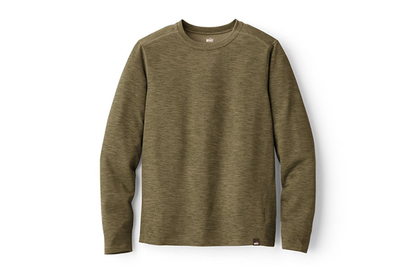
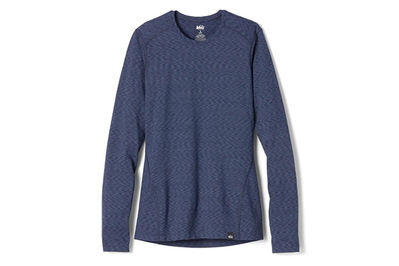
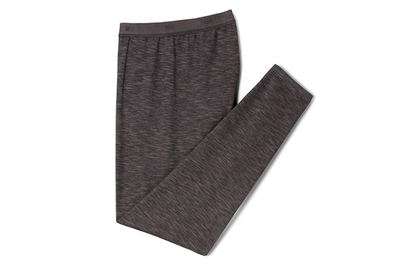
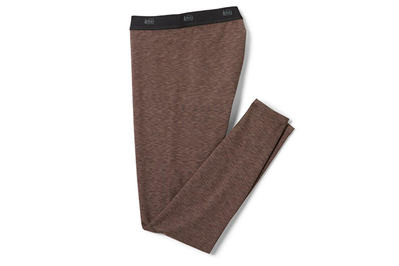
Get these if: You're trying an outdoor activity for the first time and you don't know whether you'll actually like it enough to stick with it.
Why they're great: The REI Co-op Midweight Base Layer Crew Top (men's and women's) and Midweight Base Layer Bottoms (men's) or Tights (women's) are made of a mix of polyester and spandex that is extremely comfortable. Soft and form-fitting without being tight, these pieces are ones you could wear all day (whereas a technical wool layer can sometimes feel like something you want to peel off right after you come inside).
Synthetics are naturally flexible, and that makes for good bottoms: If you squat, the fabric moves with you. The shirts are also tagless for comfort. Because these pieces are so soft, they're good at transitioning from outdoors to indoors. If, for example, you attend a football game and then go home, or if you finish skiing and then sit around the fire, it's nice not to have to change out of your clothing immediately.
Both the tops and bottoms are substantial enough to be worn alone, though they do look more like long underwear (especially the leggings) than other options. If you want bottom layers that you can wear on their own as pants, try the Smartwool Merino 250 Base Layers, which we discuss in the Competition section.
Flaws but not dealbreakers: None of our testers had anything bad to say about this crew-and-leggings combination. If you know what activity you like to do, and you don't mind the feel of wool, we think a merino pair of base layers is a better investment. However, not everyone knows exactly what they're looking for right when they start off. If that's the case, we think these REI layers won't disappoint.
Sizes: S to XXL; fits a 36- to 53-inch chest
Colors: four heathered solid colors
Material: 92% polyester, 8% spandex
Sizes: XS to XL; fits a 32- to 42½-inch chest
Colors: five heathered solid colors
Colors: asphalt (heathered gray)
Material: 92% polyester, 8% spandex
Sizes: XL and XL Petite; fits a 36-inch waist
Colors: black/asphalt (heathered black and gray)
For hiking and backpacking: Smartwool Merino 150 Base Layer Long Sleeve
Our pick
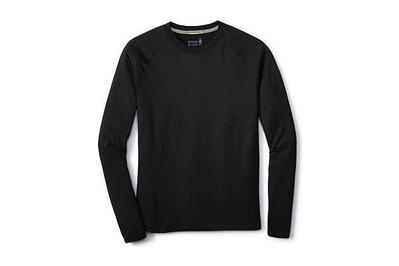
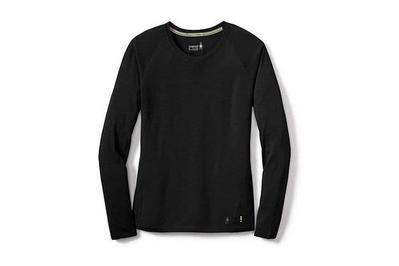
Get this if: You'll be wearing a backpack a lot of the time and you might encounter sunny weather. The Smartwool Merino 150 Base Layer Long Sleeve top (available in men's and women's versions) is comfortable to wear all day—even in the afternoon, when the sun might make an appearance and warm things up.
Why it's great: This basic, functional merino wool shirt is a good option if you're going to be outside all day—it's available in more light colors than the Ridge, so it's a better choice if the weather will be bright and you'll be moving a lot.
This shirt is tagless, its material is soft to the touch, and the cut is fitted but not skintight. You don't need to change out of it to be comfortable, either when you stop backpacking for the day or when you sit down for some food after a long day hike. The fabric is 87% merino wool blended with nylon.
The cut makes this shirt functional for long days with a backpack. It has a raglan sleeve (like the Ridge layer), so the shoulder seams are offset (meaning they're not directly on top of your shoulder). If you're wearing a backpack, especially a heavy one, that's a benefit because you don't want the straps to push the shirt seam into your shoulders and cause chafing. The high crewneck keeps sun off your chest in the afternoon.
A lot of great base-layer tops out there come only in black. This makes a shirt a little less versatile because if it's worn by itself on a sunny day, the shirt will still be too hot. By contrast, the Smartwool 150 shirt also comes in some lighter colors. So it can be useful as an underlayer and also as a standalone shirt, because you can wear it on a sunny day without sweating to death.
Flaws but not dealbreakers: We don't recommend the matching bottoms for this top because many testers didn't like the fit. But we're not too concerned because generally when you are backpacking, the conditions aren't quite cold enough to warrant a bottom base layer. There isn't anything notably bad about this shirt. If it gets a lot of wear, and a lot of washing, this shirt may need to be replaced at the end of the season. But it's no different from any other merino garment on this list in that regard, and you probably won't have to launder it all that often because it won't begin to smell as quickly as a synthetic layer will. We do wish, however, that the top came in a wider range of sizes.
Material: 87% merino wool, 13% nylon
Sizes: S to XXL; fits a 36- to 51-inch chest
Colors: five solids and two stripes
Material: 87% merino wool, 13% nylon
Sizes: XS to XL; fits a 32- to 42-inch chest
Colors: four solids and one stripe
To wear under rain gear or waders: Minus33 Midweight Wool Base Layers
Our pick
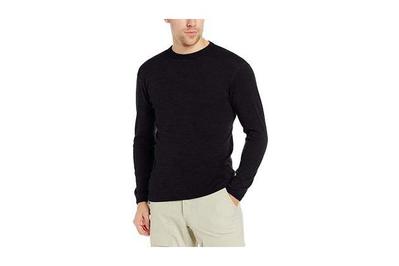
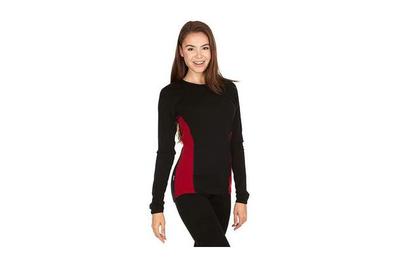
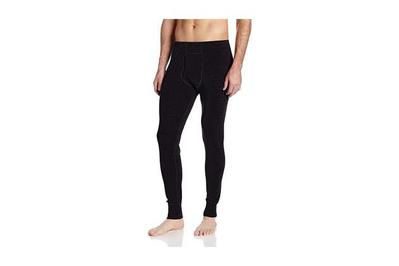

Why they're great: Not to be confused with our budget option (32 Degrees), Minus33 is a completely different brand of much higher quality. These pieces are the most durable layers in this guide.
The Minus33 crew and bottom are both 100% merino, which normally would be a red flag in the longevity department. But this material is a heavier-weight fabric than most, and that thickness alone adds a significant amount of durability. The seams are flatlocked, so they'll resist pulling apart for a long time, and in our tests these pieces came out of the washer and dryer three times without any wear that we could notice. Every garment in this guide is machine-washable, and we did wash all of them in testing to make sure. But we know from experience that thinner wools, no matter what the label says, simply do not stand up over time to washing and drying. After wearing the Minus33s for a full snowboarding season, Eve didn't notice that they showed any significant wear and tear.
In addition to the durability, these layers remain soft, and they're thick, too. As a result, they're very comfortable, and slightly warmer, to wear during lower-intensity activities like standing in a river waiting for fish to bite or sitting down on a sled.
The wool fiber is 18.5 microns thick, just like the wool in the Ridge top we recommend, and that makes these pieces wearable against the skin. (For comparison, a scratchy wool sweater may have fibers that are 50 microns thick.) More-form-fitting layers, the kind that really wick sweat away during high-intensity activities, sometimes sacrifice a little of that comfort.
These layers come in extended sizing, including tall sizes.
Flaws but not dealbreakers: Because these pieces are specifically great for hunting, fishing, and wearing under snow pants and jackets, they're not as versatile as other options. They're too thick to wear under normal clothing, the pants are too underwear-like to wear alone, and they're all too heavy for high-intensity sports like running. But that's what we'd expect for a garment intended to layer under rain gear.
Material: 100% merino wool
Sizes: XS to 6X; fits a 33- to 61-inch chest
Colors: eight solids and one camo
Material: 100% merino wool
Sizes: XS to XXXL; fits a 32- to 47-inch chest
Colors: eight solids, two two-tone, and one camo
Material: 100% merino wool
Sizes: XS to 6X; fits a 24- to 56-inch waist
Colors: eight solid colors and one camo
Material: 100% merino wool
Sizes: XS to XXXL; fits a 24- to 39-inch waist
For sports practice and obstacle races: Under Armour ColdGear Base 3.0 Crew
Our pick

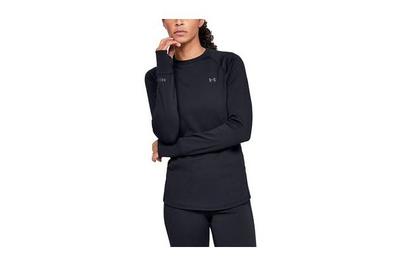
Get this if: You're playing touch football, running a Tough Mudder, or going to sports practice after school. The Under Armour ColdGear Base 3.0 Crew, in men's and women's versions, is ideal for anyone who gets really dirty and needs to clean their base layer often.
Why it's great: A wool top isn't always the best choice for activities where mud is involved because wool doesn't hold up to a lot of washing. And wool is also not necessary if you're doing an activity that requires constant output, like running, because there really is not much heat to regulate (only to release). Basic, functional, and often on sale, the Under Armour ColdGear Base 3.0 Crew is a synthetic shirt, so it can go into the wash a lot more often. And the smooth fibers help it shed dirt and debris more easily than a merino wool shirt.
The "3.0" refers to the weight of the shirt (it also comes in 2.0 and 4.0 versions). We've found that this version offers the right thickness for staying warm in early spring or late fall.
Our testers didn't like the matching Base Leggings as much as they did the top, because the waistband sat a bit low and squeezed a lot. If you need some leggings for high-output activity in the cold, winter running tights are a better bet; we have a women's pick in our running gear guide.
Flaws but not dealbreakers: Under Armour seems to favor a cut that is generous in the shoulders. It's just something to be aware of, since this shirt didn't fit some of our very tall and skinny testers as well as they had hoped.
Material: 81% polyester, 19% Elasterell
Sizes: S to XXXL; fits a 30- to 54-inch chest
Material: 81% polyester, 19% Elasterell
Sizes: XS to XXL; fits a 32½- to 46½-inch chest
Techy layers for active snow sports: Icebreaker BodyfitZone Merino 260 Zone Long Sleeve Crewe Thermal Top and Thermal Leggings
Our pick
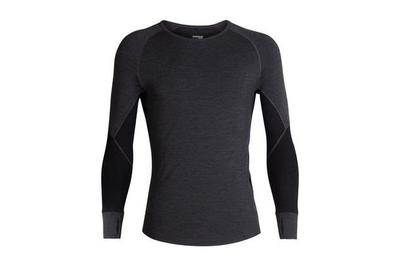
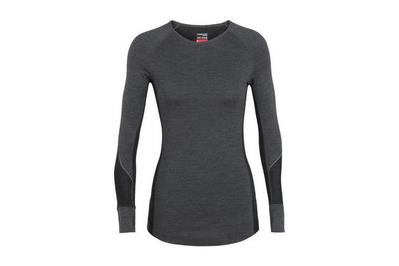
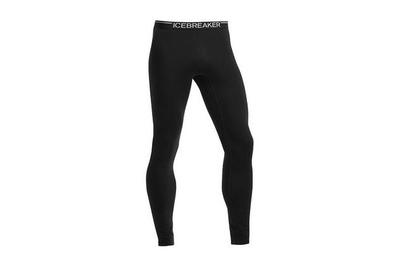
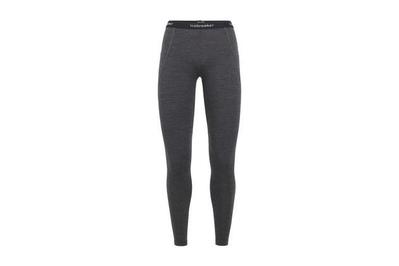
Get these if: You do a lot of cold-weather aerobic activity, such as skiing, snowboarding, or running. The goal of the Icebreaker BodyfitZone Merino 260 Zone Long Sleeve Crewe (in men's and women's sizes) is to aggressively dump heat you generate while you're moving and then keep you warm when you've stopped. The BodyfitZone Merino 260 Zone Leggings (in men's and women's sizes) do the same.
Why they're great: These base layers are pieced together with two different weights of fabric. The heavyweight panels cover places that are exposed to the cold, such as your shoulders, quads, and calves; the lightweight panels cover the places that generate heat, such as your armpits and the backs of your knees. The goal of these leggings is to keep you both warm and cool through a greater range of body-temperature fluctuation than usual. Ideally that means you don't overheat while you're skiing down a hill, but you also stay warm when you're sitting on the lift going back up. Do they achieve this goal? We think so—our testers definitely found a difference in comfort.
Icebreaker addresses other comfort issues, too: The shirt has offset shoulder seams, no tag, and a long torso to cover the back. Thumbholes make layering easy and cover the wrists for additional warmth.
We'd like to mention that the 260 Zone Leggings are some of the best leggings we've ever tested. This is the only merino bottom (aside from the Le Bent design) that doesn't pull or restrict anywhere and thus provides an unhindered range of motion. We don't know why. We don't know whether this is a result of how these leggings are pieced together or due to the tiny bit of stretchy Lycra, but people who slide down snowy hills universally love them. Eve has had her Icebreaker bottoms stolen twice—once by a couch-surfing snowboarding chick and once by her ex-boyfriend, never to be seen again.
Flaws but not dealbreakers: After a full season of wearing the shirt, one tester found that it had developed tiny holes. But he didn't consider this to be a dealbreaker—he wasn't surprised to see some wear and tear after 100-plus days of sweaty, next-to-skin contact. These pieces also don't come in as many sizes as we'd like.
Material: 97% merino wool, 3% elastane (body); 98% merino wool, 1% elastane, 1% nylon (panels)
Sizes: S to XXL; fits a 33- to 48-inch chest
Colors: Jet Heather/Black
Material: 97% merino wool, 3% elastane (body); 98% merino wool, 1% elastane, 1% nylon (panels)
Sizes: XS to XL; fits a 30- to 42-inch chest
Colors: Jet Heather/Black
Material: 97% merino wool, 3% elastane (body); 98% merino wool, 1% elastane, 1% nylon (panels)
Sizes: S to XXL; fits a 27- to 42-inch waist
Material: 97% merino wool, 3% elastane (body); 98% merino wool, 1% Lycra, 1% nylon (panels)
Sizes: XS to XL; fits a 24- to 35-inch waist
The difference between thermal underwear and base layers
We haven't found any official definition that makes a clear distinction between thermal underwear and base layers. However, after looking at hundreds of garments, we have definitely identified a difference, and it involves how you use them.
If we had to parse it, we'd say overall that base layers are for regulating heat, and thermals are meant to retain heat. Base layers are for being active and getting sweaty in, whereas thermals are for being stationary, like sitting or lounging. And of course there is a lot of crossover, so both types of garments can work for a variety of situations.
To be more specific, a base layer is a piece of activewear that wicks moisture away from your body. It's a garment that keeps you the most comfortable anytime you're working up a sweat outdoors in cooler weather—if you're hiking, backpacking, running, practicing sports, doing fieldwork, fishing, hunting, or shoveling snow.
The reason is that moisture next to your body will chill you when you stop moving. Depending on what you're doing, that can either be a slight annoyance (because you feel a chill) or a life-threatening situation (if you're wet and unable to get indoors, and you become hypothermic).
Base layers also retain and release heat according to whether you're moving or not, which is why we say they're for heat regulation instead of just retention. When you're standing still, the garments cover your skin, keeping your body warm. When you're moving, the heat you generate doesn't remain trapped (as it does with waffle-style thermal underwear) but instead moves through the fibers and out the other side, away from your body.
Almost all of the base layers we recommend in this guide are made of merino wool, or a wool blend. It's what sheep wear outdoors, all the time, in wind, rain, snow, and sun: a fiber that miraculously does all the things we described above. Synthetic base layers, typically made of nylon or some type of rayon, aren't bad, but they perform differently. They typically cost less and can be more durable, but they also smell icky—quickly.
Thermals, on the other hand, are meant to keep you warm. They're a layer of clothing you can wear alone or under a sweater or pants, indoors or out, to keep you toasty in wintry weather. For instance, you'd wear thermals to sit in the bleachers at a football game, to lounge around a cold house, or to layer under regular clothing before you go outside.
They can also be made of merino. And we even have some picks in this guide, such as the layers from Le Bent, that are ideal to wear underneath clothing. But the type of fabric is less important in this situation because you're not necessarily planning to sweat in these clothes. Without the need to wick away moisture, a cotton or synthetic thermal is an okay choice—think of the classic army-issue waffle thermal. Those materials cost a lot less than merino.
How we picked and tested
We also talked to experts. We interviewed Justin Lichter and Shawn Forry, the first and only known people to hike the Pacific Coast Trail in winter, and we spoke with Alli Noland, who has worked for almost a dozen base layer companies. (At the time of our interview, Noland did not represent any of the companies we considered.) In addition, we conversed with Outi Pulkkinen, then the design director of merino wool apparel company Duckworth, and Pierre Kim, SVP of product development for men's apparel company Rhone at the time of our interview. We also spoke to Robert Thomas, then the senior apparel product line manager at Smartwool.
This is what we found and how we chose our test pool:
Fabric: Both wool and synthetic base layers have their advantages, as we say above. But for sweating outdoors in cooler temperatures, cotton isn't the best choice. It absorbs water, which when trapped next to skin in winter weather can make you cold (or hypothermic, in a worst-case scenario). We set aside all the thermal and long johns base layers that were made of cotton; those make better pajamas than base layers.
Fit: Base layers keep you warm by trapping heat in the small gap between your skin and the fabric. This gap allows you to keep a relatively consistent temperature, like being in your own temp-regulated bubble. The key is to make sure that gap is the right size.
Winter-adventuring duo Justin Lichter and Shawn Forry suggested that a base layer top should have a relaxed fit—trim enough to layer over without being bulky. It doesn't necessarily have to be skintight, but it should not hang loosely from any part of your body. It should be long enough in the arms to cover your wrists and long enough in the torso to cover your back when you bend over, because these are places where you lose body heat.
Comfort: There are some design features that can add to the comfort of any layer. Flatlock seams are one such feature, and offset shoulder seams are also helpful. That way, if you have a backpack on, the seam won't rub into your shoulder; several of our winning layers have a raglan or offset sleeve specifically for this reason. Layers without tags are also more comfortable, and layers that don't restrict movement are essential. And finally, they shouldn't make you itch.
Function: Among men's pieces, we looked for bottoms that had a working fly. Runners, specifically, may not need a functional fly on their bottoms because they're going to get their workout done before they have to go to the bathroom. For all-day outdoor activities, however, our testers told us a fly was absolutely essential. In addition, we considered layers with zip necks, which help regulate heat; thumbholes, which prevent the shirt from bunching up when you're putting on a sweater; garments made with specialized weaving techniques like lofted knitting and heat mapping (which designers accomplish by making a garment different thicknesses in different areas, to help regulate heat); and washability. Some pieces fared better than others in the washing machine, but the bottom line is that the seams should not start unraveling after one wash.
We did several things to test the layers. First, we inspected the construction of each garment. And then we put them in a washer and dryer, even if the care instructions said not to, because this is real life.
In addition, we tested the air-dry time for these layers. We ran all the layers through the wash and hung them up, ordering the layers based on how moist they felt right after the spin cycle. Then, every five minutes, we rearranged the order based on moistness until all the layers were dry, recording how long each layer took to attain dry status. We did this test inside a garage, outdoors at night, and outdoors during the day, and we got comparable results for each testing period. It quickly became obvious how poorly some of the pieces worked in this regard, staying damp for days.
We did an in-person fit test, in addition to going by the specs listed online. The way something fits in real life can still be quite different. So our testers conducted an extensive round of real-life try-ons to see how the garments were cut and meant to fit the body.
Our 13 testers hiked, skied, snowboarded, mountaineered, and climbed their way through months of use. At minimum, nearly all of our testers had thru-hiked a 2,000-plus-mile trail—an experience that requires living in the same base layer for four to six months. So they had opinions.
What to look forward to
Another season, a million new base-layer options. We are currently considering both the lightweight and the merino base layers from REI Co-op; base layers from Brynje, Craft, Mons Royale, Ortovox, Ibex, Voormi, Montbell; and finally the new Core line from Le Bent.
In addition, we're adding a new silk base layers category to our test pool, and we'll look at both Terramar and REI Co-op silk layers.
Other good base layers
If you need something inexpensive: There are a handful of other cheap options out there, but we like the 32 Degrees Lightweight Baselayer Crew top (in men's and women's sizes) and the 32 Degrees Lightweight Baselayer Leggings (in men's and women's sizes) because they're stretchy and comfortable, and they come in a ton of colors and sizes. Every ski bum we know has, at some point, worn a pair of 32 Degrees until they're threadbare.
The men's leggings come with a working fly, something that certain leggings at 10 times the price don't have. And the 32 Degrees shirts are longer than, for instance, the shirts in the Uniqlo Heattech Collection, so they'll cover your back when you bend over.
One major caveat: These are not durable layers. One tester put his foot through a pair of leggings on the second wearing. Another tester has a top that developed small tears after two weeks. A third tester mentioned that his leggings turned his legs black. We'd expect these layers to last maybe one season, and they'll likely get damaged along the way. But sometimes you just need something cheap.
If you don't mind waiting for things to get restocked: We still really like Le Bent base layers (formerly our pick for layering underneath clothing). The only reason we moved them out of our main lineup is because they have been so hard to find.
In addition, Le Bent replaced its Le Base 200 Lightweight base layers with Core 200 Base Layer Crews (men's and women's) and Core 200 Base Layer Bottoms (men's and women's); we haven't been able to get a pair, again due to stock issues, so they remain untested.
If you're okay with (or prefer) patterns or prints on your base layers: Consider the Kari Traa Smekker Half Zip and Kari Traa Smekker Pant—super-soft, form-fitting merino-blend layers (designed for women) that come in patchwork-patterned designs. You may have noticed that we try to choose plain or mostly plain options as our top picks, because everyone's taste is different. That's the main reason the Kari Traa layers aren't currently a pick. However, they are Eve's new favorite snow gear items. These layers fit the curves of her body as well as the Le Bent base layers do (our current top choice for next-to-skin contact). And she likes that the patterns on these add coverage, since many layers we've tested are kinda see-through. Kari Traa also makes a synthetic version of these base layers, the Perle Top and Perle Pant.
If you want a shirt you could wear to dinner after a day of outdoor activity: The men's and women's Smartwool 250 Base Layer Crew and men's and women's Smartwool 250 Base Layer Bottom would be the layers to get. They are comparable to the thicker Minus33 base layers. The only reason we didn't make them a pick is that they're a little more expensive. But their added benefit is that they look like clothing, not just underwear.
The competition
The Smartwool Intraknit base layers for men and women impressed some testers but not others. These pieces are for high-intensity activities, comparable to the Icebreaker BodyfitZone line. But overall both the men and the women on our testing panel liked the fit of the Icebreaker crewneck (and zip-neck) pieces better.
The Patagonia Capilene Air Crew for men and women has been dumbfounding us for years. It fits next to the skin, but the fabric is thicker because of the weave—so it's sort of a base layer and sort of a mid-layer. Our testers haven't seemed to like the cut, but then they end up wearing it all season long. Bottom line: It does get worn, but people tend to use it more like a sweater than a base layer, so it's not a great contender for this guide. It also pills very quickly.
Sizing runs small on the Icebreaker Oasis Long Sleeve Crewe for men and women, and several testers wished the sleeve and shirt length were longer.
The Uniqlo Heattech Crew Neck Long-Sleeve T-shirt for men and women isn't designed for the outdoors. When we washed it and hung it up, we found that the high proportion of rayon made this shirt dry more slowly than other synthetic pieces, so it would remain wet for too long to keep you warm.
Sizing ran small on the Hot Chillys Micro-Elite Chamois Crewneck for men and women, and it retained a plasticky odor after several washes. If you wanted something similar, we think you'd be happier with the Ridge Merino Aspect crew or even with the Under Armour ColdGear Base 3.0 (which is a synthetic shirt like the Hot Chillys).
The men's Duckworth Vapor LS Crew is an everyday shirt like the Ridge Merino Aspect, but it has a looser fit (which the company says is an intentional design to trap more warm air against the body). However, in our tests that meant it wasn't always able to wick away sweat. It would make a better travel shirt or a summer layer, since it comes in lighter colors.
The Kora Shola 230 Crew for men and women was a midweight yak-wool base layer, similar to our Smartwool pick. But testers found it to be itchy, especially against chest hair. As with the top, testers weren't convinced the Kora Shola 230 Leggings for men and women were worth the price. (Kora has renamed its Shola layers since we last tested them; we'll take a look to see if the fabric has changed as well.)
The men's Lululemon Metal Vent Tech Long Sleeve lacks the fit, flair, and design we would expect for the price. Testers thought it felt tight in the armpits.
The Houdini Desoli Top is very thin and lightweight. That can be an advantage in the summer, if you need to stay cool and protected from the sun. But a lot of testers (both men and women) were concerned that their nipples were somewhat visible. That's not as much of an issue when you're all layered up, but many testers found that the top lost the versatility of being used as a simple shirt. The merino Desoli Tights didn't have quite enough stretch to beat out the comfort of our picks.
Like the Uniqlo top, the men's Uniqlo Heattech Long Johns had one of the worst drying times in our tests, so they don't disperse moisture. They also start to smell very quickly. The 32 Degrees leggings will serve you better.
The fabric around the thighs, butt, calves, and ankles was loose on both the men's and women's L.L.Bean Cresta Wool Ultralight Base Layer Pants. The fit on the Minus33 layers was much more tailored overall and fit more of our testers better.
The men's Bn3th Classics Full Length bottoms (which we tested when they were named the MyPakage Weekday First Layer) are made of modal, and they had a drying time similar to that of cotton in our tests (which we expected).
This article was edited by Ria Misra and Christine Ryan.
Source: https://www.nytimes.com/wirecutter/reviews/best-mens-base-layers-and-thermal-underwear/
0 Response to "Patagonia Womens Merino Thermal Weight Zip Neck Blue Stripe"
Post a Comment